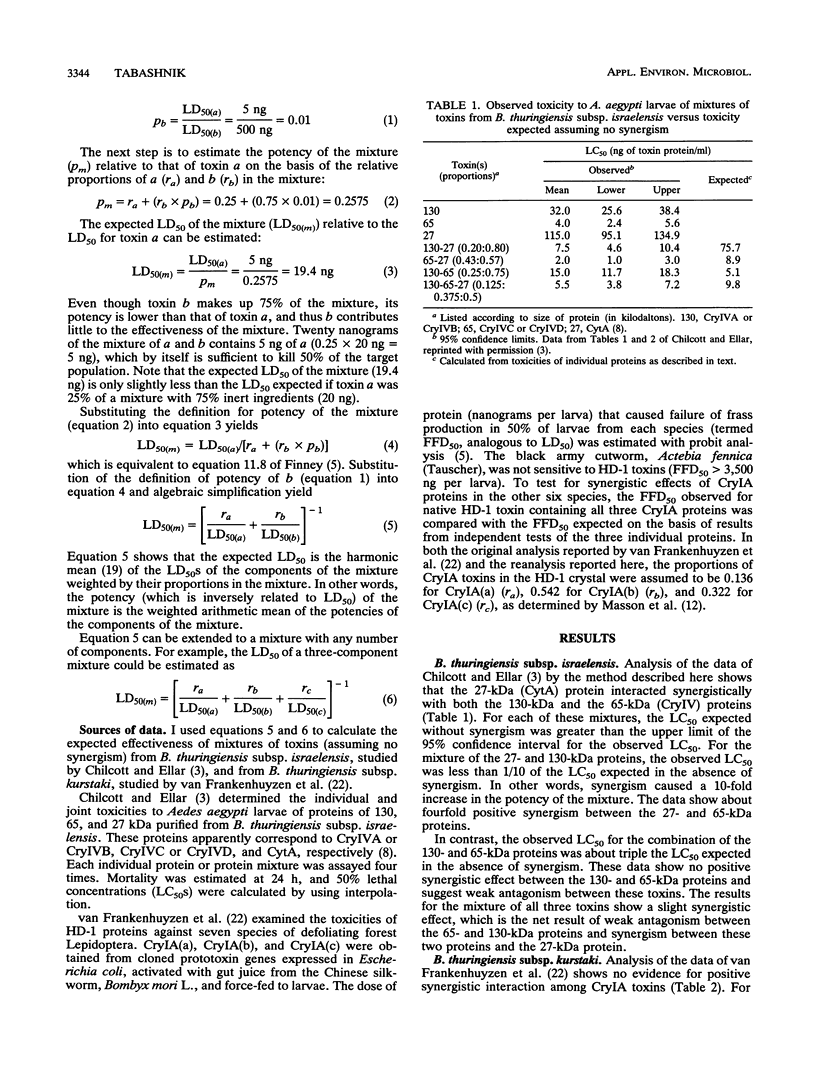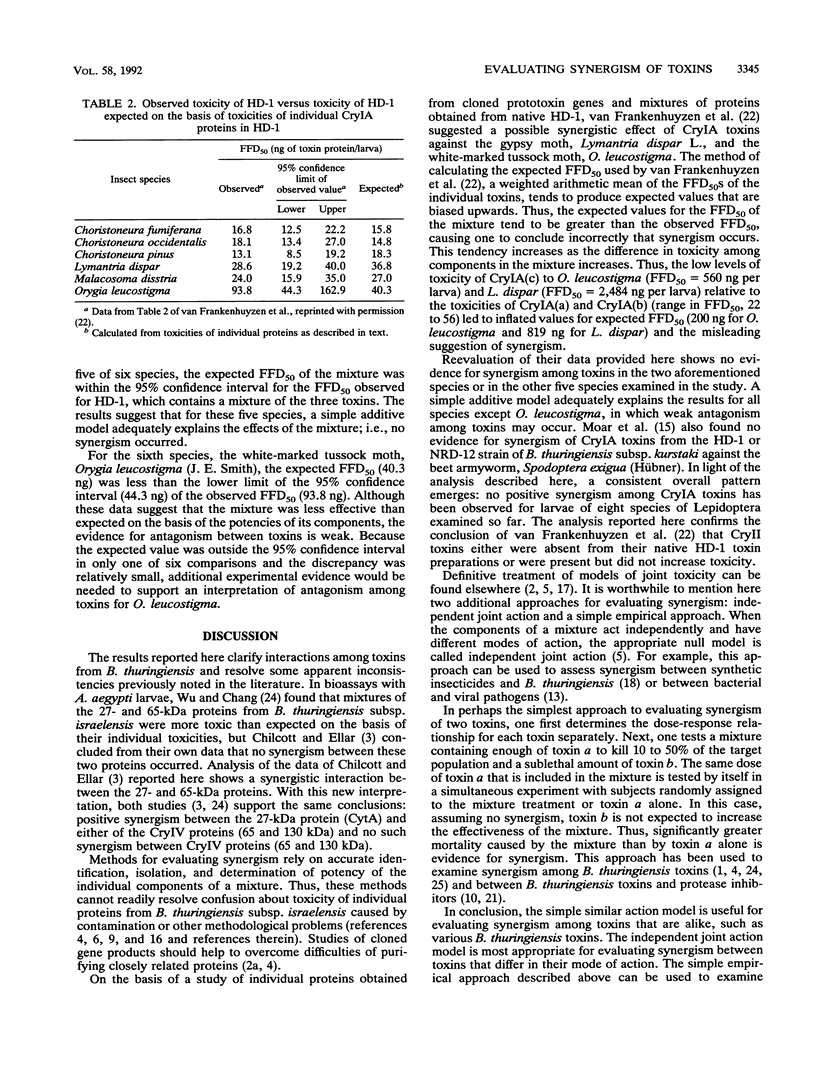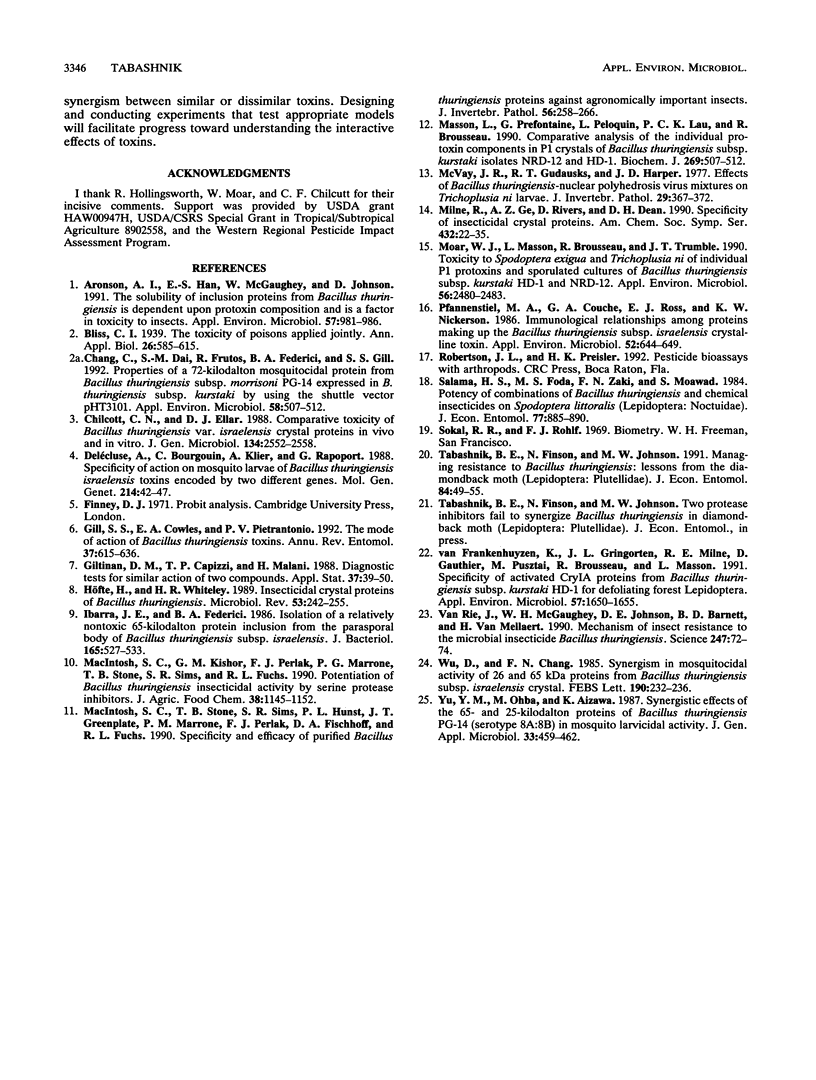Abstract
A simple test for synergism among toxins is described and applied to previously reported data on independent and joint toxicities of insecticidal proteins from Bacillus thuringiensis. The analysis shows synergism between a 27-kDa (CytA) toxin and 130- or 65-kDa (CryIV) toxins from B. thuringiensis subsp. israelensis against Aedes aegypti larvae. No positive synergism between 130- and 65-kDa toxins or among three CryIA toxins tested against seven species of Lepidoptera occurred. Comparisons with the original interpretations of these data show one case in which synergism occurred but was reported previously as absent and two cases that were not synergistic but were reported previously as suggestive of synergism. These results show that lack of an appropriate test for synergism can produce misleading conclusions. The methods described here can be used to test for synergistic effects of any poisons.
Full text
PDF



Selected References
These references are in PubMed. This may not be the complete list of references from this article.
- Aronson A. I., Han E. S., McGaughey W., Johnson D. The solubility of inclusion proteins from Bacillus thuringiensis is dependent upon protoxin composition and is a factor in toxicity to insects. Appl Environ Microbiol. 1991 Apr;57(4):981–986. doi: 10.1128/aem.57.4.981-986.1991. [DOI] [PMC free article] [PubMed] [Google Scholar]
- Chang C., Dai S. M., Frutos R., Federici B. A., Gill S. S. Properties of a 72-kilodalton mosquitocidal protein from Bacillus thuringiensis subsp. morrisoni PG-14 expressed in B. thuringiensis subsp. kurstaki by using the shuttle vector pHT3101. Appl Environ Microbiol. 1992 Feb;58(2):507–512. doi: 10.1128/aem.58.2.507-512.1992. [DOI] [PMC free article] [PubMed] [Google Scholar]
- Chilcott C. N., Ellar D. J. Comparative toxicity of Bacillus thuringiensis var. israelensis crystal proteins in vivo and in vitro. J Gen Microbiol. 1988 Sep;134(9):2551–2558. doi: 10.1099/00221287-134-9-2551. [DOI] [PubMed] [Google Scholar]
- Delécluse A., Bourgouin C., Klier A., Rapoport G. Specificity of action on mosquito larvae of Bacillus thuringiensis israelensis toxins encoded by two different genes. Mol Gen Genet. 1988 Sep;214(1):42–47. doi: 10.1007/BF00340177. [DOI] [PubMed] [Google Scholar]
- Gill S. S., Cowles E. A., Pietrantonio P. V. The mode of action of Bacillus thuringiensis endotoxins. Annu Rev Entomol. 1992;37:615–636. doi: 10.1146/annurev.en.37.010192.003151. [DOI] [PubMed] [Google Scholar]
- Höfte H., Whiteley H. R. Insecticidal crystal proteins of Bacillus thuringiensis. Microbiol Rev. 1989 Jun;53(2):242–255. doi: 10.1128/mr.53.2.242-255.1989. [DOI] [PMC free article] [PubMed] [Google Scholar]
- Ibarra J. E., Federici B. A. Isolation of a relatively nontoxic 65-kilodalton protein inclusion from the parasporal body of Bacillus thuringiensis subsp. israelensis. J Bacteriol. 1986 Feb;165(2):527–533. doi: 10.1128/jb.165.2.527-533.1986. [DOI] [PMC free article] [PubMed] [Google Scholar]
- MacIntosh S. C., Stone T. B., Sims S. R., Hunst P. L., Greenplate J. T., Marrone P. G., Perlak F. J., Fischhoff D. A., Fuchs R. L. Specificity and efficacy of purified Bacillus thuringiensis proteins against agronomically important insects. J Invertebr Pathol. 1990 Sep;56(2):258–266. doi: 10.1016/0022-2011(90)90109-j. [DOI] [PubMed] [Google Scholar]
- Masson L., Préfontaine G., Péloquin L., Lau P. C., Brousseau R. Comparative analysis of the individual protoxin components in P1 crystals of Bacillus thuringiensis subsp. kurstaki isolates NRD-12 and HD-1. Biochem J. 1990 Jul 15;269(2):507–512. doi: 10.1042/bj2690507. [DOI] [PMC free article] [PubMed] [Google Scholar]
- Moar W. J., Masson L., Brousseau R., Trumble J. T. Toxicity to Spodoptera exigua and Trichoplusia ni of individual P1 protoxins and sporulated cultures of Bacillus thuringiensis subsp. kurstaki HD-1 and NRD-12. Appl Environ Microbiol. 1990 Aug;56(8):2480–2483. doi: 10.1128/aem.56.8.2480-2483.1990. [DOI] [PMC free article] [PubMed] [Google Scholar]
- Pfannenstiel M. A., Couche G. A., Ross E. J., Nickerson K. W. Immunological relationships among proteins making up the Bacillus thuringiensis subsp. israelensis crystalline toxin. Appl Environ Microbiol. 1986 Oct;52(4):644–649. doi: 10.1128/aem.52.4.644-649.1986. [DOI] [PMC free article] [PubMed] [Google Scholar]
- Van Rie J., McGaughey W. H., Johnson D. E., Barnett B. D., Van Mellaert H. Mechanism of insect resistance to the microbial insecticide Bacillus thuringiensis. Science. 1990 Jan 5;247(4938):72–74. doi: 10.1126/science.2294593. [DOI] [PubMed] [Google Scholar]
- van Frankenhuyzen K., Gringorten J. L., Milne R. E., Gauthier D., Pusztai M., Brousseau R., Masson L. Specificity of Activated CryIA Proteins from Bacillus thuringiensis subsp. kurstaki HD-1 for Defoliating Forest Lepidoptera. Appl Environ Microbiol. 1991 Jun;57(6):1650–1655. doi: 10.1128/aem.57.6.1650-1655.1991. [DOI] [PMC free article] [PubMed] [Google Scholar]


